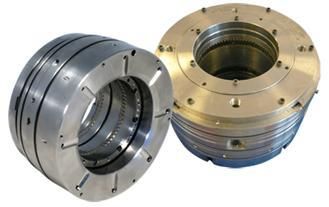Towards better labyrinth seals

Labyrinth seals, non-contact type mechanical seals, consisting of a series of annular orifices or cavities, are critical components in a centrifugal gas compressor. They are used on the impeller i.e., on the shaft between impellers, and on the balance piston to seal a high-pressure area from a low-pressure area. The seal's annular cavities provide a tortuous path that minimizes gas leakage.
Such seals have different configurations depending on the location of teeth and the mating sealing surface. In a Tooth on Rotor (TOR) configuration, seal rotating teeth are sealing against a smooth abradable stationary surface. In a Tooth on Stator (TOS) configuration, seal stationary teeth are sealing against a smooth rotating surface. A combination of these two types is called the Interlocking or High-Low configuration.
Labyrinth seals can affect gas compressor efficiency and reliability. Efficiency can be improved by reducing the labyrinth seal clearance and leakage. Traditionally, OEMs have designed and built gas compressors with aluminum labyrinth seals. However, there are certain limitations when aluminum is used.
In the case of a rotor contact, an aluminum seal tooth tip will deform permanently. After the contact (rub), the seal tooth remains deformed and excessive clearance results, leading to increased gas leakage and lower compressor efficiency.
Moreover, aluminum seals cannot be designed with reduced clearances due to their permanent deformation property. And galling can occur on the rotating surface leading to vibration problems.
Thermoplastics
In recent years, seal manufacturers have used performance polymers in many labyrinth seal applications. The most successful thermoplastics for labyrinth seals are polyether ether ketone (PEEK), polyamideimides (PAI), and polytetrafluoroethylene (PTFE) compounds. Only a limited number of suppliers can mould these materials as well as machine-finish labyrinth seals. These seals offer longer life than aluminum seals and are non-galling when coming into contact with the rotor.
Several grades of PEEK, PAI, and PTFE compounds are commercially available. But only some specific grades have been successfully used for centrifugal compressor labyrinth seals. Material properties and quality are influenced by the fillers, compounding molding and stress relieving processes. The majority of thermoplastic labyrinth seals are machined from hot compression molded stock shapes due to larger seal sizes and shorter run quantities.
Labyrinth seals are usually designed with tighter tolerances on ID dimensions. In order to achieve such tolerances, it is necessary to stress-relieve thermoplastic materials after molding and rough machining. PEEK materials are post-cured to increase material crystallinity and reduce molding stresses.
Raju Kalidindi is a Senior Materials and Applications Engineer for EGC Critical Components, a division of Fenner Advanced Sealing Technologies based in Houston, Texas. For more information, visit egccomponents.com or call 281.774.6100.
(Read more in the September/October 2015 issue of Turbomachinery International)